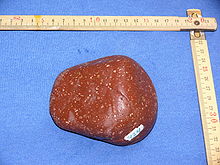
Back صخر سماقي Arabic Porfir Azerbaijani Парфір Byelorussian Парфір BE-X-OLD Pòrfir Catalan Porfyr Czech Porfyr (bjergart) Danish Porphyr German Porfiro Esperanto Pórfido Spanish



Porphyry (/ˈpɔːrfəri/ POR-fə-ree) is any of various granites or igneous rocks with coarse-grained crystals such as feldspar or quartz dispersed in a fine-grained silicate-rich, generally aphanitic matrix or groundmass. In its non-geologic, traditional use, the term porphyry usually refers to the purple-red form of this stone, valued for its appearance, but other colours of decorative porphyry are also used such as "green", "black" and "grey".[1][2]
The term porphyry is from the Ancient Greek πορφύρα (porphyra), meaning "purple". Purple was the colour of royalty, and the Roman "imperial porphyry" was a deep purple igneous rock with large crystals of plagioclase. Some authors claimed the rock was the hardest known in antiquity.[3] Thus porphyry was prized for monuments and building projects in Imperial Rome and thereafter.
Subsequently, the name was given to any igneous rocks with large crystals. The adjective porphyritic now refers to a certain texture of igneous rock regardless of its chemical and mineralogical composition or its color. Its chief characteristic is a large difference in size between the tiny matrix crystals and the much larger phenocrysts. Porphyries may be aphanites or phanerites, that is, the groundmass may have microscopic crystals as in basalt, or crystals easily distinguishable with the eye, as in granite.
- ^ BRADLEY, M. (2006). COLOUR AND MARBLE IN EARLY IMPERIAL ROME. The Cambridge Classical Journal, 52, 1–22. http://www.jstor.org/stable/44698291
- ^ Mari 2015: Z. Mari, “The Marbles from the Villa of Trajan at Arcinazzo Romano (Rome)” in P. Pensabene, E.Gasparini (edited by) Interdisciplinary Studies on Ancient Stone, ASMOSIA X, International Conference (Rome, 2012), Rome 2015
- ^ "porphyry". Oxford Dictionary of Byzantium. New York & Oxford: Oxford University Press. 1991. p. 1701. ISBN 0195046528.